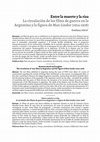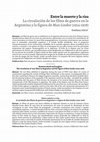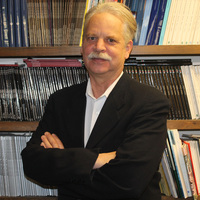Papers by Emiliano Jelicié
Vivomatografías. Revista de estudios sobre precine y cine silente en Latinoamérica, Dec 24, 2020
El arribo del film d'art a la Argentina (1908-1913) Apropiaciones lejanas de un dispositivo de pr... more El arribo del film d'art a la Argentina (1908-1913) Apropiaciones lejanas de un dispositivo de promoción del cine Emiliano Jelicié * Resumen: Este trabajo aborda las condiciones de circulación, recepción y legitimación del film d'art en la Argentina bajo la perspectiva del dispositivo promocional desplegado para tales fines. La confluencia de este hecho comercial y cultural sin precedentes con el surgimiento de las primeras secciones de crítica de cine en la prensa gráfica argentina (junto con otras innovaciones locales que impulsaron la puesta en valor del espectáculo cinematográfico), constituye el punta pié inicial para abordar un conjunto más amplio de rasgos y apropiaciones que iluminan una zona de la historia del cine en la Argentina poco explorada hasta nuestros días.

The war films exhibited in Argentina during the years of WWI were object of a series of controver... more The war films exhibited in Argentina during the years of WWI were object of a series of controversies regarding the control of foreign films’ distribution in the country. As propaganda films, at first they constituted a threat to the alleged Argentine neutrality, and the State decided to prohibit them. But the growing evidence of the sympathy of the Argentine society for the allies, smoothed the problem of censorship and this genre of films became the symptom of an internal dispute between the main entrepreneurs of the film business in Argentina. The spoils of the dispute were the films from France, which paradoxically would be displaced by Hollywood at the end of the war. In this process, the star figure of Max Linder appears to Argentine viewers as the other side of the coin. Renowned representative of a dominant comic model during the heyday of French cinema, Linder succumbed to the irruption of a new aesthetic regime inaugurated by Hollywood, with Charles Chaplin at the forefro...

The war films exhibited in Argentina during the years of WWI were object of a series of controver... more The war films exhibited in Argentina during the years of WWI were object of a series of controversies regarding the control of foreign films’ distribution in the country. As propaganda films, at first they constituted a threat to the alleged Argentine neutrality, and the State decided to prohibit them. But the growing evidence of the sympathy of the Argentine society for the allies, smoothed the problem of censorship and this genre of films became the symptom of an internal dispute between the main entrepreneurs of the film business in Argentina. The spoils of the dispute were the films from France, which paradoxically would be displaced by Hollywood at the end of the war. In this process, the star figure of Max Linder appears to Argentine viewers as the other side of the coin. Renowned representative of a dominant comic model during the heyday of French cinema, Linder succumbed to the irruption of a new aesthetic regime inaugurated by Hollywood, with Charles Chaplin at the forefro...
Review of Pablo Ansolabehere's book . Homero Manzi va al cine . Buenos Aires: Libraria, 2018... more Review of Pablo Ansolabehere's book . Homero Manzi va al cine . Buenos Aires: Libraria, 2018, 176 pp., ISBN 978-987-3754-20-3. Key words: review, Pablo Ansolabehere, Homero Manzi, cinema ___________ Sobre Ansolabehere, Pablo. Homero Manzi va al cine Resumen: Resena del libro de Ansolabehere, Pablo. Homero Manzi va al cine . Buenos Aires: Libraria, 2018, 176 pp., ISBN 978-987-3754-20-3. Palabras clave: resena, Pablo Ansolabehere, Homero Manzi, cine ___________ Sobre Ansolabehere, Pablo. Homero Manzi va al cine Resumo: Resehna do livro de Pablo Ansolabehere. Homero Manzi va al cine . Buenos Aires: Libraria, 2018, 176 pp., ISBN 978-987-3754-20-3. Palavras chave: resehna, Pablo Ansolabehere, Homero Manzi, cinema _____________ Date of reception: 16th November, 2019 Date of acceptance: 2nd December, 2019

The photographer, journalist, writer, and filmmaker Alejandro Del Conte is today well-known for h... more The photographer, journalist, writer, and filmmaker Alejandro Del Conte is today well-known for his fundamental role in the development, dissemination and professionalization of artistic photography in Argentina. Little is known, however, of the varied and absolutely pioneering projects that this multifaceted character developed in the field of production, distribution, exhibition and, above all, regional film criticism. In fact, in addition to exhibiting, renting and directing films in the north of the country and in Buenos Aires, during 1917 Del Conte founded and directed an early coorporative magazine dedicated to cinema in the city of Tucumán, which is almost unknown today: the Film Gráfico Revista Semanal Cinematográfica del Norte de la República. Based on his personal correspondence and archive, and on the few surviving copies of this publication, in this work we intend to reconstruct this unique and ambitious editorial project as well as the role that this publication had in ...











Uploads
Papers by Emiliano Jelicié